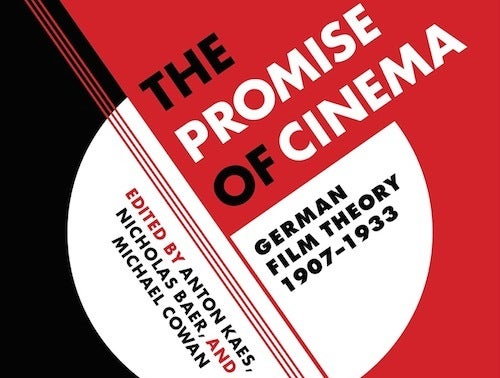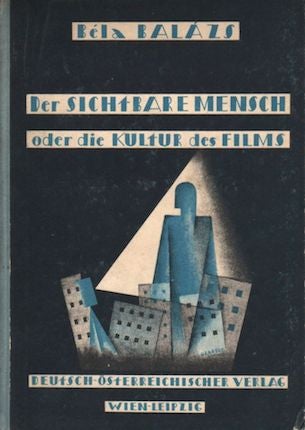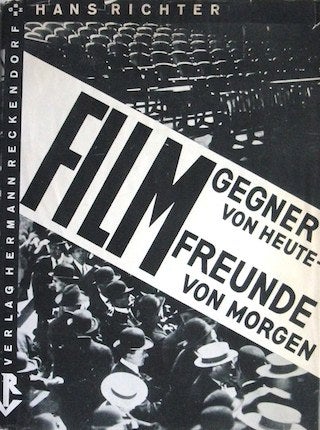
UC Press, 2016
In June, the University of Leipzig hosted “A Hundred Years of Film Theory. Münsterberg and Beyond: Concepts, Applications, Perspectives,” which explored the work of the Harvard psychologist who published one of the first sustained works of film theory in 1916. Unfortunately, Hugo Münsterberg’s The Photoplay: A Psychological Study, was quickly forgotten, because the German national had made himself extremely unpopular as an advocate for Imperial Germany in World War I. But it is not surprising that a German psychologist should theorize about cinema, given the intense German interest in film theory as documented in The Promise of Cinema: German Film Theory 1907-1933, edited by Anton Kaes, Nicholas Baer, and Michael Cowan. While Münsterberg was a bit of an anti-modernist and 19th century Neo-Kantian, applying idealist aesthetics to the new medium, theorists in the present volume contributed to the discourse on German modernity in the last century. All these theorists are however less concerned “with cinema in its current, often-compromised forms than with what it might become” (p. 3). In other words, its future. Indeed, one of the great pleasures of reading The Promise of Cinema is seeing how contemporaries grappled with a medium still in the process of formation, during a period of massive social paradigm shifts. Film theory is defined here in the spirit of contemporary film studies as “the entire network of discourses” on film as art, entertainment and social phenomenon, and thus we are presented not only with a history of film theory, but also with a history of the medium.
As early as the 1910s, the cinema became a contested site for German intellectuals, the medium being perceived as either a positive force in changing human perception or as a negative force, leading to the moral degradation of the lower classes, depending on whether the writer was a conservative critic of modernity or a liberal advocate for popular culture. The anthology’s dates, 1907-1933, mark the founding of the first film journals in Berlin, and the fall of the Weimar Republic and rise of Nazism, the end of any discussion within a free press, but also a time when the medium moved from a fairground diversion to a mass medium. The diversity of German thought on film has been apparent for decades, ever since Anton Kaes published an anthology in German, Kino-Debatte (1978), but that was a slim volume compared to the massive tome in front of us. And for English speakers, it is the mature film theories of Siegfried Kracauer, Rudolf Arnheim and Béla Balázs from the 1920s that have previously defined German film theory. All three theorists, like Lotte Eisner, began as daily film critics, so it’s not surprising that almost all of the 278 essays in the present volume were first published in the film press.
While Balázs is represented with 13 essays, Kracauer with 12 essays, and Eisner with four, the anthology also collects essays from numerous other film critics, writers, directors and actors. Well-known film critics include Herbert Tannenbaum, Kurt Pinthus, Hans Siemsen, Willy Haas, Hans Feld and Herbert Ihering. Among the German literary figures represented are Hanns Heinz Ewers, Max Brod, Walter Hasenclever, Alfred Polgar, Joseph Roth, Alfred Döblin, Kurt Tucholsky, Karl Kraus, Axel Eggebrecht, Robert Musil, Vicki Baum, Ernst Toller, Hugo von Hofmannsthal, Ernst Jünger and Carlo Mierendorff. Contributing filmmakers include Fritz Lang, Berthold Viertel, Leni Riefenstahl, Paul Wegener, Erich Pommer, Joe May, Ernst Lubitsch, Carl Laemmle, Billy Wilder, Karl Ritter, G.W. Pabst, Walter Ruttmann, Robert Wiene, Hans Richter, Paul Leni, Karl Freund and Edmund Meisel. Each essay is accompanied by a brief editor’s introduction and annotations, providing valuable context for those not necessarily familiar with the German cultural sphere.


The Promise of Cinema is divided into three more or less equal sections with six sub-headings, addressing practically all aspects of the cinema, but focusing on film and modernity, film and cultural context, and film and media theory. “Transformations of Experience” covers changes in human perception, shifting conceptions of space and time, the presentation of the body, film spectatorship, and the cinema’s relationship to other arts. “Film Culture and Politics” deals with turn of the century reform movements, film and the state, the German film industry’s relation to Hollywood, the star system, film as propaganda, and cinema as philosophy. “Configurations of the Medium,” then, presents essays on German Expressionism, avant-garde film, film aesthetics, educational films, sound, and future technologies like 3-D, color, and television. Most importantly, this broadly defined structure allows readers to see the many parallels with today’s media studies, including “immersion and distraction, participation and interactivity, remediation and convergence… amateur filmmaking and fan practices, democracy and mass media…” (p. 9).
I will only quote one case in point, regarding the astounding relevance to today’s evolving digital media landscape. In a Béla Balázs review from 1925 of the Shakleton and Scott expedition films, he could be writing about the iPhone:
“This is a new form of self-reflection. These people reflect themselves by filming themselves. The inner process of accounting for oneself has been externalized. This self-perception until the final moment is mechanically fixed. The film of self-control, which consciousness used to run within the brain, is now transposed onto the reel of the camera, and consciousness, which has mirrored itself for itself alone in internal division until now, delegates this function to a machine that records the mirror image for others to see as well. In this way, subjective consciousness becomes social consciousness.”
The Promise of Cinema is unbelievably rich in such material for thought. Reading a few essays at a time is the way to go. Almost all of the essays have been translated specifically for this volume and I would like to commend the translators on their work. Having done quite a bit of translation work from German myself, I know that one of the fatal weaknesses of translations into English from German is that they often still sound like German, given German’s syntax rhetoric, but these texts read as if they were written by native speakers. That is no mean feat, and it makes perusing The Promise of Cinema both an intellectual and a reading pleasure.
< Back to Archival Spaces blog






 Mobile Navigation
Mobile Navigation

